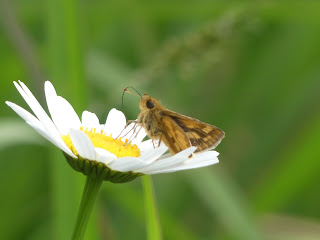Spiny Softshell Turtles
I found a trail near the intersection of South Bridge Street and Route 206 in Somerville. I think it's considered a part of the Raritan River Greenway that seemingly connects to the Peter's Brook Greenway [1]. I noticed some large turtles basking on the opposite side of the river, figured they were Northern Red-bellied Cooters, and followed a side trail to get a better look.
Here's a picture of 1 that returned from the water in the short time that I was photographing her companions.
As I approached (but still being across the river) most of the turtles scurried into the river. But a couple stayed on the riverbank, and they weren't cooters. They were a species I had only photographed once before at the Raritan Water Power Canal, Spiny Softshell Turtles. While my previous sighting gave me an impression of a smallish spotted turtle though, these turtles were large and (mostly) uniform in color [2]. Apparently young Spiny Softshells have spots, and some of the males retain those spots. This means my previous sighting was either young, male, or both.
Interestingly, my Field Guide to Reptiles and Amphibians of New Jersey states that the Northern Red-bellied Cooter is the largest basking turtle in our area. Yet the dimensions it gives for the Spiny Softshells is larger than for the cooters. Here are my possible explanations for this:
- While the female Spiny Softshells can be a bit bigger than our cooters, the male Spiny Softshells are only about half that size. If you average them, the cooters probably have a slight size edge.
- The Spiny Softshells have a very flat look to their shells. Perhaps they weigh less even when their shell dimensions are somewhat larger than our cooters.
- Spiny Softshells are native to the Midwest US, and are probably less common. Perhaps the description of the cooters was intended to cover the most commonly spotted basking turtles.
- Basking is something most turtles, including our snapping turtles, will occasionally do. Perhaps the Spiny Softshells aren't found out in the open basking often enough to acquire the "basking turtle" moniker.
Though the leathery look of their shells is a good explanation of the "softshell" part of their name, the "spiny" part is more evident up close. The front of the shell has small, pointy "spines" near the head/neck.
I observed 1 interesting behavior in both my sightings of this turtle. Even though they're easily frightened into diving into the water, they're surprisingly quick to return to land afterward. During both encounters I noticed the turtles returning to bask even though I was in the same spot that triggered them to dive into the water. If you think you missed a chance at seeing 1 of these turtles, it might be worth hanging around for a couple minutes to see if they just come back.
 |
| April 24, 2023 at the Raritan River Greenway Photo 272682577, (c) jpviolette, some rights reserved (CC BY-NC) |
Here's a picture of 1 that returned from the water in the short time that I was photographing her companions.
 |
| April 24, 2023 at the Raritan River Greenway Photo 272682620, (c) jpviolette, some rights reserved (CC BY-NC) |
[1] Or maybe part Peter's Brook Greenway is considered a part of the Raritan River Greenway; some literature implies that the Raritan River Greenway starts where the Raritan River North and South Branches meet and ends where the Raritan River meets the Millstone River. When I tried asking those wiser than myself, Bing's AI said "I'm sorry, I couldn't find the answer to your question." and ChatGPT just "spun its wheels". Even artificial intelligence is stumped. 😄
[2] Both turtle sightings showed scute-less turtles, with scutes being those shell sections we find on all our native turtles (even if they're harder to distinguish on some species).
[3] Common Snapping Turtles can be bigger, but infrequently get out of the water to bask, so they don't count as "baskers".



Comments
Post a Comment